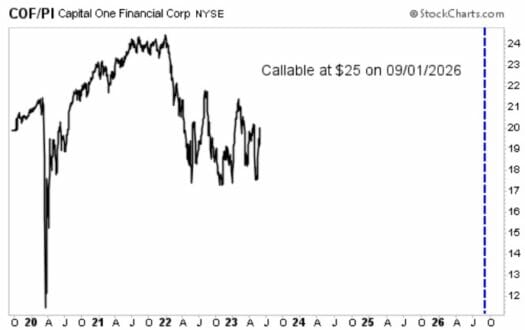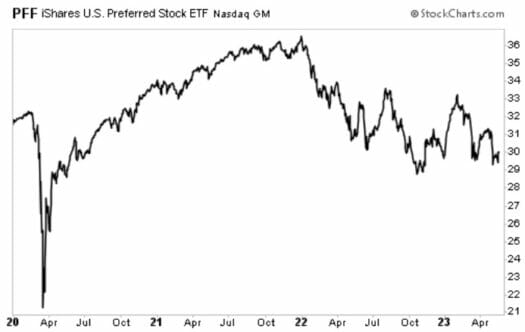Safe, High Yields Make This Little-Known Asset Class A No-Brainer…
Common. By definition, it sounds plain. Ordinary.
On the other hand, preferred has a much nicer connotation. Who wouldn’t rather have access to the preferred parking lot? Or preferred seating at stadiums and concert venues? It’s a descriptor typically indicative of a few extra perks.
The same is true in the financial world. Common and preferred stocks both convey equity ownership in a business. But while the former grants voting rights, the latter carries something even better: preferential dividend treatment.
I wrote about the ins and outs of preferred stocks (and why they make sense right now) in this article. But, as promised, I want to elaborate further today — and even give some examples of how investors can profit.
An Investment For the Income Connoisseur
Let’s start with a real-world example. Capital One Financial (NYSE: COF) offers a standard dividend yield on its common shares of 2.7%. Nothing wrong with that; it’s well above the market norm. But the bank has also issued 27 million shares of series ‘L’ preferreds (NYSE: COF-PL). This class has a fixed coupon of 4.375%.
Based on the $25 face value, that works out to an annual dividend of $1.09, distributed in four quarterly installments of $0.273, payable each March, June, September, and December. Already, that’s about 60% more income than you’d get from the common stock.
But thanks to the disarray in the regional banking sector, this preferred stock has been driven down to $17.20 per share as of this writing. With that steep discount, the fixed payout of $1.09 now equates to a handsome yield of 6.5% ($1.09/$17.20).
So a $10,000 stake in the preferred stock will net $710 in yearly dividends versus $270 for the common stock.
I believe both payouts are on solid ground. Capital One is in fine financial shape. Coincidentally, this is one of the few banks Buffett has been buying rather than selling (Berkshire just disclosed a $1 billion stake). But if conditions worsen and cash flows do start to deteriorate, the common stock dividend would be sacrificed before the preferred stock — which has a higher priority.
Call Features & Interest Rate Sensitivity
How long will the gravy train last? Well, some preferreds have stated maturity dates 20 or 30 years in the future, although most are “perpetual.” But that doesn’t necessarily mean they are permanent. In this case, COF-PL is callable starting on September 1, 2026.
After that date, Capital One has the right to redeem the outstanding shares at the full $25 face value. Still, after entering at $17.20 and exiting at $25, buyers would pocket an extra $7.80 in capital appreciation on top of the dividends. Not exactly the worst outcome.

Keep in mind, though, call features are designed to benefit the issuer, not the investor. Borrowers are always keen to minimize finance costs. So redemptions are more common during periods of falling rates. The lower future interest rates fall below the coupon, the more likely the preferred will be redeemed and a new series issued at the cheaper prevailing rate (just as you or I would refinance a house).
Capital One would be more inclined to refinance a 4.375% rate if future borrowing costs are at 3% than 6%.
As redemption becomes more likely, it’s normal for preferred stocks to gravitate back toward par value. That can mean gains for securities bought at a discount to par or losses for those purchased at a premium. This can present some uncertainty.
You might see a preferred stock trading at $26.50 with a par value of $25. If the stock is called, the investor would cash out with a loss of $1.50 per share. That modest setback might be more than offset by higher dividends in the interim. Still, don’t be caught off guard by call features.
In the meantime, expect to pocket steady payments every 90 days — often at two to three times what the issuer pays its common stockholders.
Let Funds Do The Work For You…
Investors have plenty of options. For some, a passive exchange-traded fund (ETF) such as iShares Preferred & Income Securities (NYSE: PFF) does the trick. It’s low-cost and offers a healthy payout above 6%. And after trading near $40 (before the Fed rate tightening cycle began), the fund is now hovering close to a multi-year low below $30.

But I prefer a hands-on approach to a rigid index for this asset class. Aside from steering clear of potential trouble and utilizing leverage to enhance returns, closed-end funds (CEFs) have another structural advantage over ETFs: they have a deeper pool to fish.
Few people know that traditional exchange-traded preferred stocks comprise only about 15% of this market. They are often referred to as the retail market. The other 85% of preferreds (some $1 trillion outstanding) only change hands over the counter between institutional investors.
Since ETFs are limited to listed securities, they are shut out of the institutional side of the market and miss out on 85% of the available universe. Institutional OTC preferreds typically offer better call protection and higher payouts. And over the past quarter century, they have outperformed their retail siblings by 1.3% annually — potentially compounding into thousands of dollars more over the long haul.
Action To Take
Hopefully, this gives you an understanding of not only how preferred stocks work, but also the myriad options for investors in this space.
After weighing over a dozen top contenders, we ended up going with a trusted leader in the CEF field over at High-Yield Investing. The fund had its struggles last year. But with Fed rate tightening having nearly run its course and the banking scare fading from the news cycle, the stage is set for a powerful bounce over the next 12 months.
That said, COF-PL looks like a compelling value right now. There are many such cases in this corner of the investing world.
Which path you choose is ultimately up to you. But if you’re looking for income, I wouldn’t ignore this asset class.
P.S. Want to get your hands on some of my absolute favorite high-yield picks? Then you need to check out my latest report…
You’ll learn about 12 ultra-generous dividend payers that put more money in your pocket. And the best part? They pay dividends monthly. Go here to learn more now.
